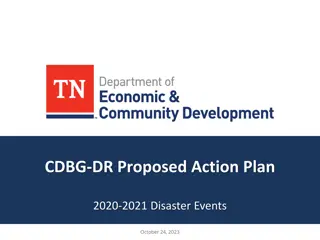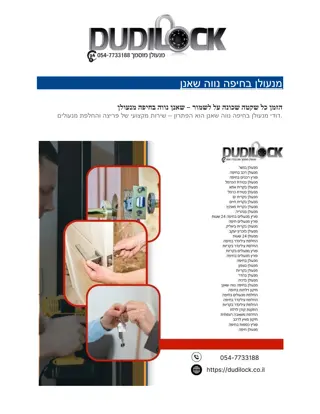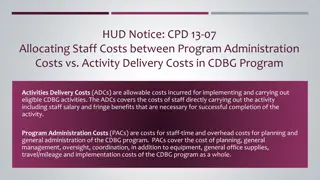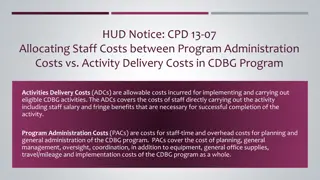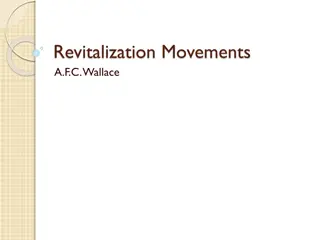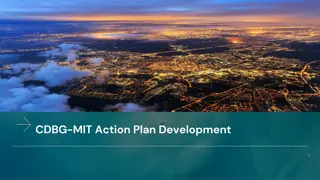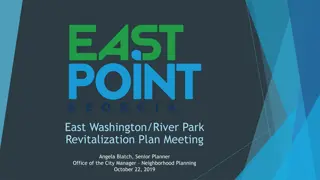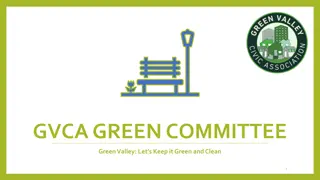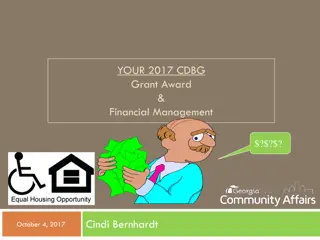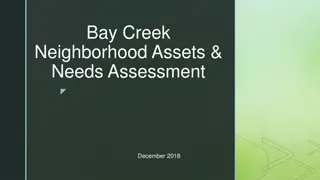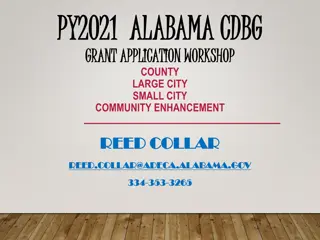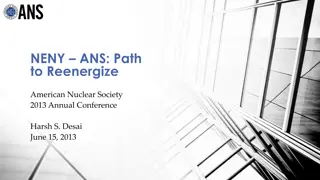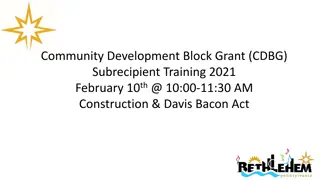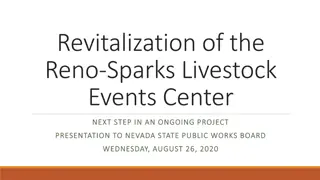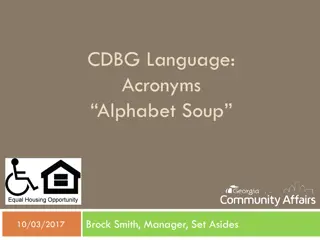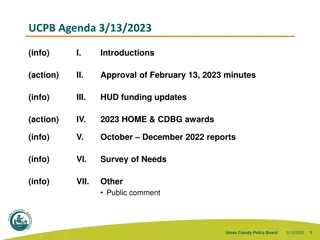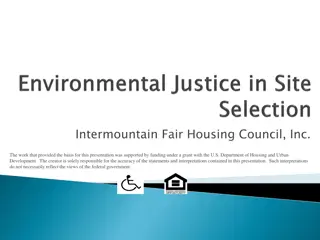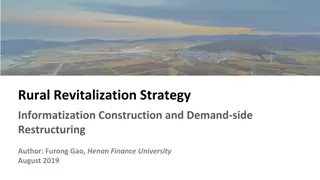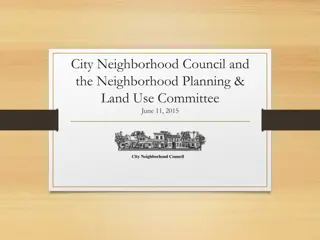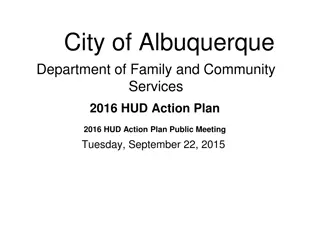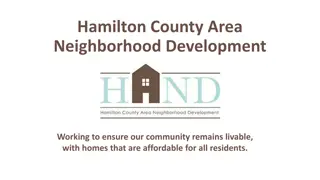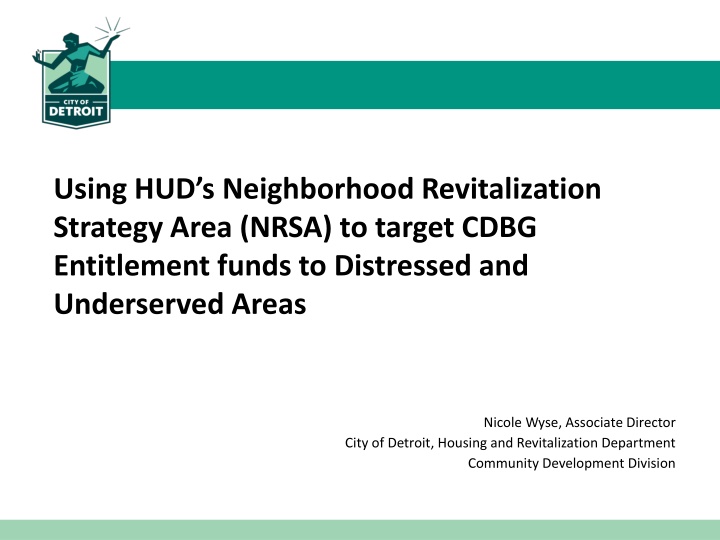
Using HUD's Neighborhood Revitalization Strategy Area to Target CDBG Entitlement Funds in Detroit
HUD refers to NRSAs as locally designated areas for targeted revitalization efforts through coordinated activities. CDBG grantees in NRSA areas have enhanced flexibility in utilizing funding for economic development, housing, and public services. NRSA plans involve significant citizen participation to align with the community's needs. Detroit, facing economic challenges, utilized the NRSA plan to focus federal resources geographically, aiming to attract private investment and address critical issues in distressed areas.
Download Presentation

Please find below an Image/Link to download the presentation.
The content on the website is provided AS IS for your information and personal use only. It may not be sold, licensed, or shared on other websites without obtaining consent from the author. If you encounter any issues during the download, it is possible that the publisher has removed the file from their server.
You are allowed to download the files provided on this website for personal or commercial use, subject to the condition that they are used lawfully. All files are the property of their respective owners.
The content on the website is provided AS IS for your information and personal use only. It may not be sold, licensed, or shared on other websites without obtaining consent from the author.
E N D
Presentation Transcript
Using HUDs Neighborhood Revitalization Strategy Area (NRSA) to target CDBG Entitlement funds to Distressed and Underserved Areas Nicole Wyse, Associate Director City of Detroit, Housing and Revitalization Department Community Development Division
What is a Neighborhood Revitalization Strategy Area? HUD refers to NRSAs as locally designated areas where geographically targeted revitalization efforts are carried out through multiple activities in a concentrated and coordinated manner (24 CFR 91.215(g)) CDBG Entitlement grantees are able to develop and implement a NRSA per 24 CFR 91.215(g) and NRSAs and their process are further defined in the HUD Notice CPD 16-16 No additional funding comes with a NRSA, however communities with HUD approved NRSAs are offered enhanced flexibility in undertaking economic development, housing and public service activities with their CDBG funding NRSA plans are 5 year plans, and typically should align with your Con Plan The creation of a NRSA plan involves heavy citizen participation with stakeholders, affected residents and organizations within the community
NRSA Flexibilities 1. Aggregation of Housing Units If 51% or more of all the assisted units in a NRSA during a program year are an LMI benefit, all units are considered as meeting the LMH National Objective. This allows grantees to assist non-LMI households 2. Jobs as LMA benefit Job creation/retention activities within a NRSA may qualify as meeting are benefit requirements, eliminating the need for grantees to track the income of persons who take, or are considered for, such jobs 3. Aggregate Public Benefits Standard Economic development activities undertaken in a NRSA are exempt from the public benefit standards. This allows grantees some flexibility with their program design and record-keeping requirements 4. Public Service Cap Exemption any public service activities undertaken by a Community Based Development Organization (CBDO) in a NRSA are exempt from their 15% public service cap
City of Detroit Economic and Neighborhood Conditions Detroit has approx. 670,031 residents (population has declined 34% since 1990) and is 139 sq. mi. of land 72% of the population are classified as low-to- moderate income (at or below 80% AMI), the 2015 median household income was $29,841 (half of the nationwide median income) There are around 365K housing units within the city 93% of the housing stock was built prior to 1978 30% of the housing stock is vacant The 2015 median value of a home was $43,900 (half the value of homes across Wayne County) In 2014, the City of Detroit was undergoing post-bankruptcy restructuring and the City struggled with retaining residents for many reasons, including lack of capital flexible enough for home repair and access to jobs The NRSA plan was considered an important tool to help the city focus its federal resources geographically and leverage private capital
City of Detroit NRSAs Application The City applied for the HUD NRSA designation in order to: stabilize the housing stock increase housing values grow small businesses prepare Detroit youth for employment build wealth for Detroit families help restore neighborhood stability for Detroit residents 2015, NRSA plan was approved by HUD and included five (5) designated NRSA areas Based on these demographics, the designated NRSAs met both criteria of having over 70% of residents considered LMI Neighborhoods with contiguous boundaries that were at least 60% or more primarily residential were considered for NRSA boundaries
City of Detroit NRSA Current Status Despite the resurgence in Downtown Detroit since 2015, slum and blighted conditions, undervalued properties and a high poverty rates continue to be a concern in the neighborhoods The NRSAs demonstrated measurable impact in targeted neighborhoods from 2014-2019, but the City still needed access to this tool to continue that progress In addition, the increase in public-private partnerships has increased the investment from the private sector in the NRSA areas. Partners including DLBA, DEGC, DESC, foundations, financial institutions, community-based organizations and private businesses have committed to continue work in Detroit neighborhoods Initiatives including the Strategic Neighborhood Fund (SNF), Affordable Housing Leverage Fund (AHLF), Choice Neighborhoods Implementation Grant (CNI) and the Housing Resource Centers (HRC) that overlap NRSA boundaries In December 2020, Detroit submitted a renewal application for its NRSA plan, and HUD approved a renewal on the NRSA plan in 2021
City of Detroit NRSA Example NRSA 1 75% LMI Rate Fiat Chrysler Engine Plant 3 SNF Neighborhoods 2 HRC s Area slated for major commercial corridor improvements, housing development, streetscape and park improvements
City of Detroit NRSA Example NRSA 1 Between 2014-2019 66 owner-occupied single family homes repaired 697 single family demolitions 25 commercial demolitions 40 small businesses received technical assistance 64 jobs created
City of Detroit NRSA programs highlighted Home Repair - 0% Home Repair Loan Program (Partner Detroit LISC, local CDFIs and HRCs) Established in 2015 to support low, moderate and middle income homeowners with much needed repairs of their home due to the aging housing stock and lack of access to capital for repairs Property rehabilitation contributes to stabilizing neighborhood housing markets and improving housing values 0% Interest Home Repair Loans are between $5,000 - $25,000 and are paid back over a 10-year term
City of Detroit NRSA programs highlighted Serves approx. 100 residents annually Leveraged funding from Bank of America and Quicken Loans ($10M) 800 loans approved, 515 home repairs completed Average household incomes range between 30% AMI up to 120% AMI Additional $12.5M in CDBG and $8M in leveraged funds expected over the next 5 years More information on the 0% Home Repair Loan Program can be found at www.detroithomeloans.org
City of Detroit NRSA programs highlighted Workforce Development (Youth Employment) - Grow Detroit's Young Talent (Partner Detroit Employment Solutions Corporation (DESC), 30 partners, 548 jobsites): DESC is part of the Michigan Works Association and serves as the workforce development agency for the City of Detroit Through partnerships with community based organizations, DESC provides employers access to Detroit talent Employs 8,000+ Detroit youth annually $7.5M in CDBG invested since 2015, $55M leveraged
City of Detroit NRSA programs highlighted GDYT is for Detroit youth ages 14-24 who have pre-determined barriers to employment GDYT works on developing soft skills needed to gain employment including: Professionalism, Time & Attendance, Financial Literacy, Customer Service, Hygiene & Workplace Appearance, Communication and Interpersonal Skills Once the participant has successfully completed this they then graduate on to working. Wide range of opportunities available (retail, office, food service) Pays $8.25/hr-$10/hr up to 120 hours during the program cycle More information on GDYT can be found at www.gdyt.org
Looking Ahead: City of Detroit NRSA next steps 2014-2019 Outcomes for all 5 NRSAs: 605 homes received home repair resources 9,223 single family structures demolished 344 commercial structures demolished Employment opportunities created for 5,000+ youth 453 new jobs created 234 small businesses assisted 2020-2024 Goals for all 5 NRSAs: Target another 875 housing units with loans and grants Demolish another 100 structures Create another 5,000 employment opportunities for Youth who live in NRSAs Create 75 new jobs Assist 500 small businesses
Thank you! Nicole Wyse, Associate Director City of Detroit Housing and Revitalization Department Community Development Division 313-224-4159 roddenbowenn@detroitmi.gov

